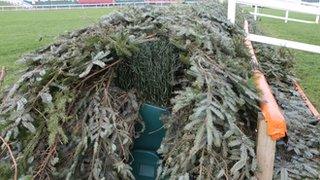Grand National fence changes trialled at Aintree
- Published
Aintree to test fences in safety review
Changes to Grand National fences were trialled at Aintree on Saturday as the racecourse tries to improve safety.
Ten horses have died in the big race over the last 12 years.
Four fences have been rebuilt using softer cores instead of the former rigid timber frame.
Two outriders were used on Saturday to help with loose horses during two races over the National fences - the Becher Chase and the Grand Sefton Chase.

One of the Aintree fences fitted with plastic birch in the middle
Both races passed without serious incident and although there were fallers in each, there were no injuries to either horses or jockeys reported.
John Baker, the regional director of Jockey Club Racecourses responsible for Aintree, said: "We were delighted with how the Grand National fences jumped today, including the trial fences, and we had some fantastic feedback from the professionals."
Jockey Robert "Choc" Thornton said on Twitter: "Great job done by Aintree racecourse and the BHA [British Horseracing Authority] with the fences. They rode great and are well presented."
Clerk of the course Andrew Tulloch was satisfied with the reaction to the fences.
"They seemed to get some favourable comments back from jockeys and it all went quite well," he said.
"We'll be sitting down and having a chat with the jockeys and assessing how we take things forward, if we take things forward, and take it from there."
Saturday was the first time the course had been used since April when the National had two equine fatalities for the second year in succession.
While all 16 fences look the same, covered in spruce brought in from the Lake District, the heart of four obstacles has been changed.
The third and 11th fences, which are open ditches, have been built using natural birch as its core, while the 13th and 14th (which are the last two fences second time round in the National) have plastic birch.
"We have traditionally had a rigid timber frame, which has foam padding along the leading edge, but is solid. We have replaced four of those with an alternative, which will be a bit more forgiving," Tulloch told BBC Sport.
"If the horse hits something solid at racing speed it can unbalance it and cause a fall, but now if horses knock the spruce off, there will be a softer frame underneath. Other horses should be able to brush through it without injuring themselves.
"If it is successful we will roll it out to the other fences. The fences are outwardly the same. We are not lowering them - that could potentially make the horses go quicker."
The move has been welcomed by the RSPCA equine consultant David Muir.
"It allows a horse to make a mistake and survive," he said.
"Previous to that when they hit the solid core of the fences, it took their legs away and it was down to luck whether they got over the other side and managed to get up again."
Several changes were announced in September for the Grand National following a safety review, but the field size will stay at a maximum of 40.
The 2012 Cheltenham Gold Cup winner Synchronised was one of two horses to die in this year's contest.
Synchronised fell at the sixth fence, Becher's Brook, but continued riderless for another five fences before fracturing his leg.
"Everything in life has a risk and our job is to minimise those risks," said Tulloch.
Following the safety review, the start of the National itself will be moved forward 90 yards, reducing the race to four miles and three-and-a-half furlongs, from four-and-a-half miles.
Other measures include £100,000 being invested in irrigation to produce "the safest jumping ground possible" and a new bypass and pen around fence four to catch riderless horses.
Neptune Collonges wins Grand National - race in full
- Published20 September 2012
- Published13 April 2012
- Published1 May 2012
- Published14 April 2012
- Published14 April 2012
- Published14 April 2012
- Published15 April 2012
- Published14 April 2012